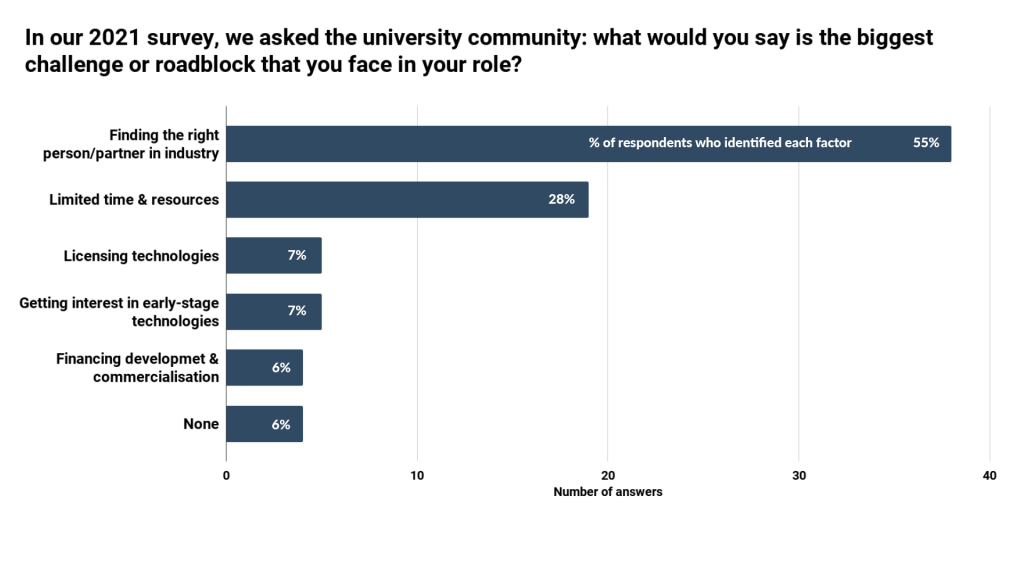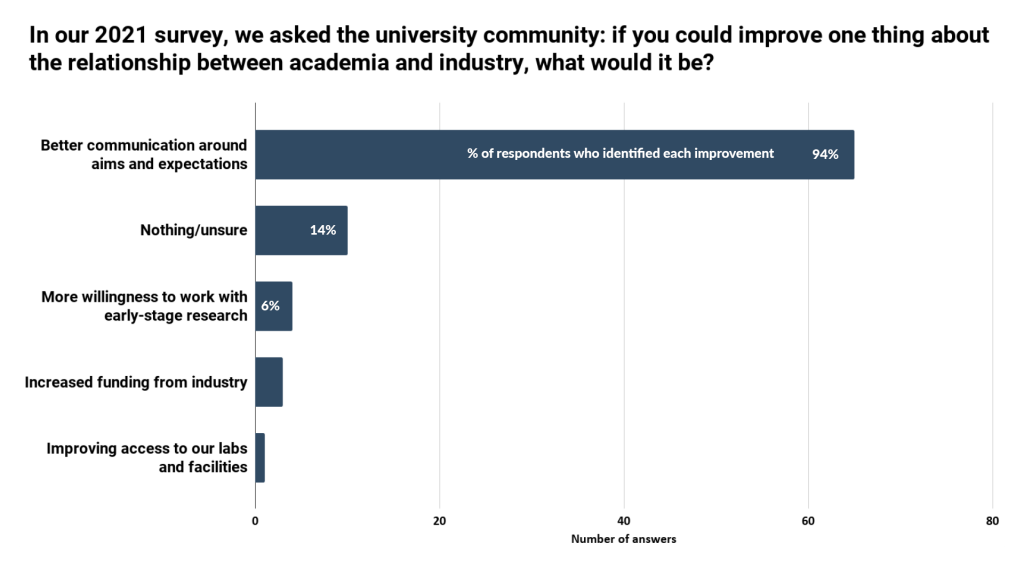Challenges for university-industry collaboration in 2021: What are technology transfer teams up against?
Last year shone a light on the benefits of university-industry collaboration and what can be achieved when there’s a common goal and understanding between technology transfer teams and industry R&D. Almost everyone has followed high-profile Covid-19 partnerships such as the AstraZeneca-Oxford vaccine, and this focus has been inspiring collaborations around the world. But despite progress, particularly for the life sciences, in some areas of collaboration, there have been setbacks to research being commercialised.
In this article, we’ll highlight some of the key findings from the annual survey we ran at the start of the year to gather the views of the global university-industry community to see how the events of 2020 have affected partnerships and how ambitions for 2021 might have changed.
In total, 69 technology transfer professionals from institutes subscribed to our university-industry matchmaking platform responded to the survey. The survey had an international reach with respondents from six continents, many from across North America and Europe, with representation from institutes in Africa, Asia, Australasia and South America, including South Africa, China, Australia and Puerto Rico. These responses come from individuals working in technology transfer, licensing, commercialisation and business engagement teams within universities.
Challenges for university-industry collaboration: What are tech transfer teams up against?
The teams working in technology transfer offices (TTOs) face many challenges in their role to make academic research have as large an impact as possible, and to maintain and improve their office’s reputation within the university and the R&D community. In order to make this happen, tech transfer teams need to find the most promising research from academics at their institute to engage industry with. Added to that, TTOs also need to identify not only relevant companies, but the right people within those companies to make contact with.
This was something we observed in our survey responses (and in the responses from our R&D community) with tech transfer professionals saying the main challenge they face is finding the right partner in industry. Given the size, complexity and global distribution of R&D-driven companies, it’s unsurprising that this is the most common issue TTOs face when approaching commercialisation. Tech transfer professionals also highlighted that they face limited time and resources, resulting in challenges effectively managing all of the research produced within their institute and personalising marketing strategies for individual technologies.

When asked about their biggest challenge for 2021, there was a range of responses. Many respondents said that they expect to still feel the effects of delays and decreased outputs from lockdown restrictions closing labs for months at a time during 2020. A similar number of people also raised concerns about needing to maintain and increase funding inputs in the light of a potential decline in public funding and budget cuts/freezes.
These factors indicate an overall struggle to increase the number of successful industry collaborations over the last year. Now more than ever research projects require industry support to get them off the ground and out into the world, but with the disruption experienced in 2020, many projects are still feeling the effects.

How could the university-industry relationship be improved?
As well as providing an assessment of the current state of play, our survey was also designed to identify potential solutions and improvements to issues that our community are experiencing. We believe that these solutions need to be guided by the needs of our community, so we asked what TTOs think could be improved about university-industry collaborations. As is the case with the R&D professionals, the overwhelming response was a desire for better communication about the aims and expectations each side has.
Unpacking the details behind this response, many of the specific suggestions we received outlined the need to clearly establish the different timelines that industry and academia work to, what each party considers to be success, and the current and long-term plans and interests of industry. This information can be used to help academics and TTOs understand exactly what is required to commercialise a project, and to help bring in earlier engagement with industry partners to guide them.

How has the pandemic affected university-industry collaboration?
In the early stages of the pandemic, universities first felt the impact as a decline in interest from industry in the form of reducing numbers of new requests for academic consultancy and the termination of existing contracts. Funding then became an issue, with spin-out companies facing concerns of raising investment. These impacts and others were explored recently in an editorial we wrote for ReseachProfessional, ‘Covid response will reset university-industry links‘.
Our 2021 survey indicates that 58% of TTO’s experienced a negative impact on their ability to collaborate with industry during the pandemic. To counter this, many universities have increased their marketing output with the aim of increasing industry interest in their partnership opportunities. Others have streamlined their approach to collaboration by reducing the time and resources needed to successfully collaborate with industry partners.

Additionally, 32% of TTO’s said they have experienced non-COVID research being deprioritised within their institution. A similar distribution of responses from R&D teams suggests universities and companies are feeling the same levels of impact.
Despite the negative impact of the pandemic on university-industry collaboration, many survey respondents also provided positives. The most common positive impact we recorded is the now-widespread use of digital communication.
Our TTO community identified that digital communication has increased the speed of setting up and running collaborations, especially with life science developments energised by the scientific community’s highly documented response to COVID-19. High-profile university-industry collaborations working to address COVID-19 have also improved the reputation and highlighted the value of developing relationships with industry.
We also found that the reduction in travelling required by academics to speak at conferences and other networking events has increased the time they have to focus on research and commercialisation. What’s more, international collaborations have also become more accessible with the increased deployment of digital communication tools.

Our 2021 annual survey also took the temperature of the R&D community. For insights on what challenges the R&D teams are facing in 2021, jump through to the companion piece for this article, ‘Challenges for university-industry collaboration in 2021: What are R&D teams up against?’.
Written by Frances Wilkinson. Edited by Alex Stockham.
Copyrights reserved unless otherwise agreed – IN-PART Publishing Ltd., 2021: ‘Challenges for university-industry collaboration in 2021: What are technology transfer teams up against?’
About IN-PART:
We believe brilliant connections can solve real-world problems. We match research pioneers from academia with decision-makers in industry sectors striving for a greater positive impact.
Our goal is to enable connections from around the world to match academic research with industry on a level playing field. Through our intelligent, matchmaking platform we showcase leading university innovations and connect academics with an international community of decision-makers in industry, creating meaningful dialogue and partnership.
IN-PART, a digital partnering platform for university-industry collaboration.
250+ universities and research institutes around the world currently showcase their research and innovation on IN-PART to find new collaboration partners in industry. R&D teams get free access to the platform (create an account here). There are no hidden costs and we don’t claim downstream success fees.
Discover, a bespoke scouting service for open innovation.
Through Discover, corporate R&D teams can leverage our extended academic network, which reaches multiple teams across 1,200+ universities and research institutes worldwide. In response to a specific research requirement or challenge, Discover enables R&D teams to identify new opportunities for commercialisation or to solicit proposals for new research.
Interested in speaking with our Discover team? Request a demo | TTO or academic? Sign-up for weekly Discover emails.

Image credit: Matt Duncan / Unsplash Licence

